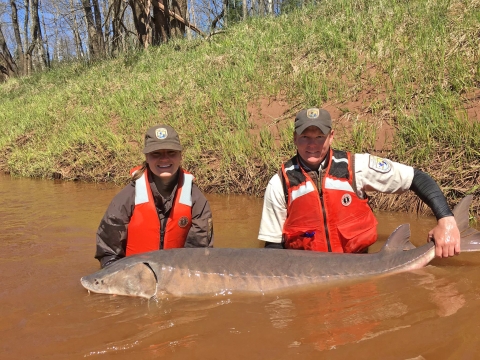BLOOMINGTON, Minn. — After conducting a thorough species status assessment using the best available science, the U.S. Fish and Wildlife Service determined lake sturgeon do not require listing under the Endangered Species Act. The Service’s 12-month finding shows ongoing management efforts, such as fish stocking, have contributed to the conservation and resiliency of the species.
“Today’s announcement shows the power of collaborative conservation and the impact it can have for species like the lake sturgeon,” said Midwest Regional Director Will Meeks. “The fact that we’re seeing more and more lake sturgeon populations spawning in their historical habitat is a clear sign that restoration efforts are progressing. This success is credited to many partners including states, Tribes, local organizations and others across the country coming together to conserve this species.”
Sturgeons have a prehistoric appearance because of their large size, shark-like tails, and bony plate-armored covering. Tracing its origins back at least 150 million years, the lake sturgeon is one of the largest freshwater fish in North America occupying rivers and lakes across the eastern and central United States and Canada.
The most widespread ongoing conservation action considered in the assessment was the stocking of captive-reared lake sturgeon. Stocking programs have led to increases in adult lake sturgeon and spawning behaviors. Although populations are not at historical levels, these successful programs have both bolstered existing populations and returned lake sturgeon to areas where they had disappeared, such as the Red River of the North, the Tennessee and Cumberland rivers, the Middle Mississippi River, and the Coosa River. Other successful conservation measures include restoring habitat connectivity through dam removal, fish passages and habitat restoration.
The Service’s not-warranted 12-month finding on the petition to list the lake sturgeon under the ESA and supporting information for the decision are available today for public inspection in the Federal Register Reading Room and will publish in the Federal Register on Tuesday, April 23, 2024. More information can be found at regulations.gov under docket number FWS-R3-ES-2024-0022.



